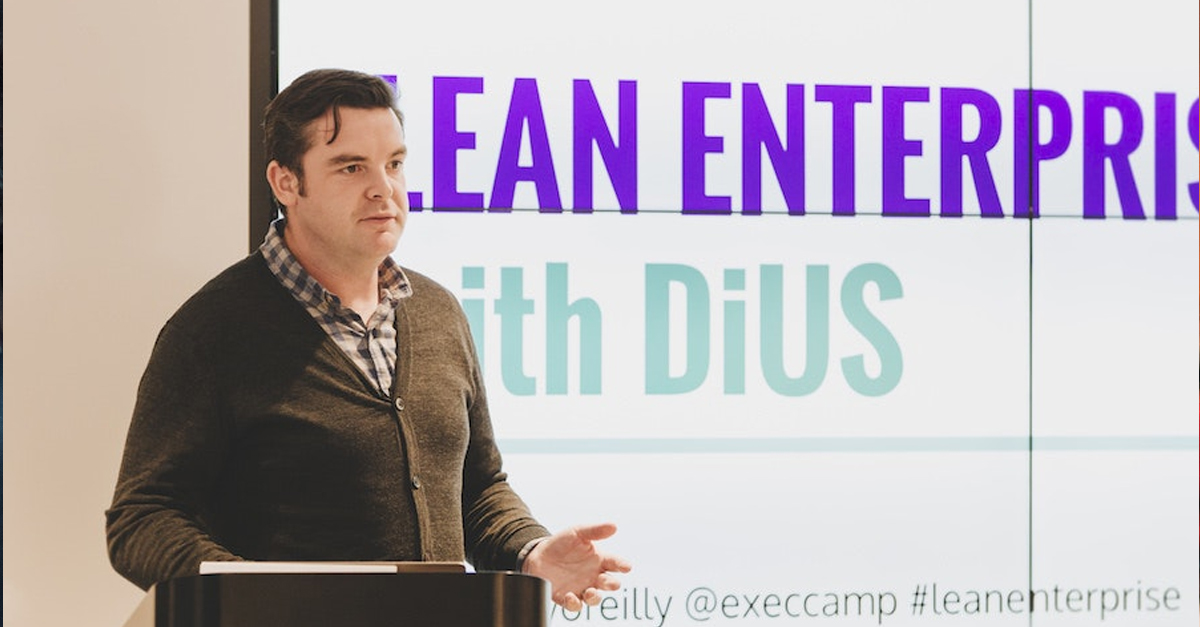As we hatch our plans for the 10th anniversary of Agile Australia, we reflected on last year’s ‘Managing the Innovation Portfolio‘ workshop in a nod to how this conference has impacted the conversation about Agile and Lean practices within our industry.
Taking book club to the next level
Late last year we read ‘Lean Enterprise’ by Jez Humble, Joanne Molesky and Barry O’Reilly – a book focused on how high performance organisations innovate at scale – at DiUS Book Club.
Our conversation was all about how we need to be shifting from the why of innovation to the how of innovation. It’s the how that gets us every time. We had a really impassioned, insightful and satisfying conversation around Lean approaches. The book wrapped up a lot of our product development thinking and gave us some new approaches to add to our kitbag.
When we found out that Barry was coming to Australia for Agile Australia 2017, we were inspired to get his help to extend our book club conversation and learnings to a broader group. Over the years we’ve noticed the same concerns being voiced over and over about how to innovate at scale within our clients – and we felt there would be significant value around getting this group together with the aim of improving their ability to tackle uncertainty.

We reached out and Barry was thrilled to be our very special guest at a “Managing the Innovation Portfolio” workshop we put on in Melbourne and Sydney. The interest was enormous: CIOs, CTOs, CX Managers and IT Strategy leaders all wanted to be part of it. They were not disappointed.
Some workshop standouts
The concept of innovation, like everything that is seemingly difficult to understand, gets easier if you break it down and visualise it. Barry’s workshop was full of real-world anecdotes and tools to help with the process. We also wanted an emphasis on applying these learnings to attendees’ challenges on the day so they could go back armed with practical ways to tackling the technological and cultural challenges associated with kindling an organisation’s innovative spirit.
Of particular interest to the group was the conversation around innovation accounting, an area that enterprises find particularly challenging. How can you fund a new activity when you’re not sure what to measure and what the results will be? These are difficult conversations to have within the traditional enterprise business case and budgeting processes.
It’s too hard to summarise all the learnings in just one post, but we wanted to share the concepts of “Hypothesis Driven Development” and the “Portfolio Mapping” as good places to start rethinking about how to manage and evaluate any type of new work in an enterprise context.

Hypothesis Driven Development
Similar to the traditional User Story format, this card is enforcing answers to hard questions. If you can’t measure it – don’t build it! If you don’t know if a particular initiative is indeed improving the status quo, you may inadvertently be making it worse without ever noticing.
By answering these questions upfront, every initiative will have clear capability and a measurable outcome. This template is not new, but Barry added a little twist to it with questions such as “How much are you willing to invest to test this outcome” or “What’s the quickest and cheapest way to get to the answer ‘no’”.

An important question to be discussed before any money is spent. But once this is decided – stop talking and start testing!
Portfolio Mapping

The second really important tool to help with innovation is the Portfolio Mapping. As Barry outlines in his blog, current initiatives can be placed in one of four columns:
- Explore – These are early stage initiatives that are bets for the future with high degrees of uncertainty
- Exploit – Initiatives that have achieved product-market fit and the organisation wants to grow and scale
- Sustain – initiatives that have become repeatable and scalable business models, products or services that drive the majority of revenue for the organisation
- Retire – initiatives that are long-lived, no longer beneficial (even limiting) to the organisation future success or strategy and should be sunset from the portfolio
Placing all initiatives in one of the four columns, not only triggers discussions, but it also helps to focus in on the right initiatives.
Not surprisingly, by actually applying these principles to their day-to-day business led to a number of A-ha moments in the audience – people were keen to get back to their workplaces and experiment with what they just learned. Which was the exact aim of the workshop series.

